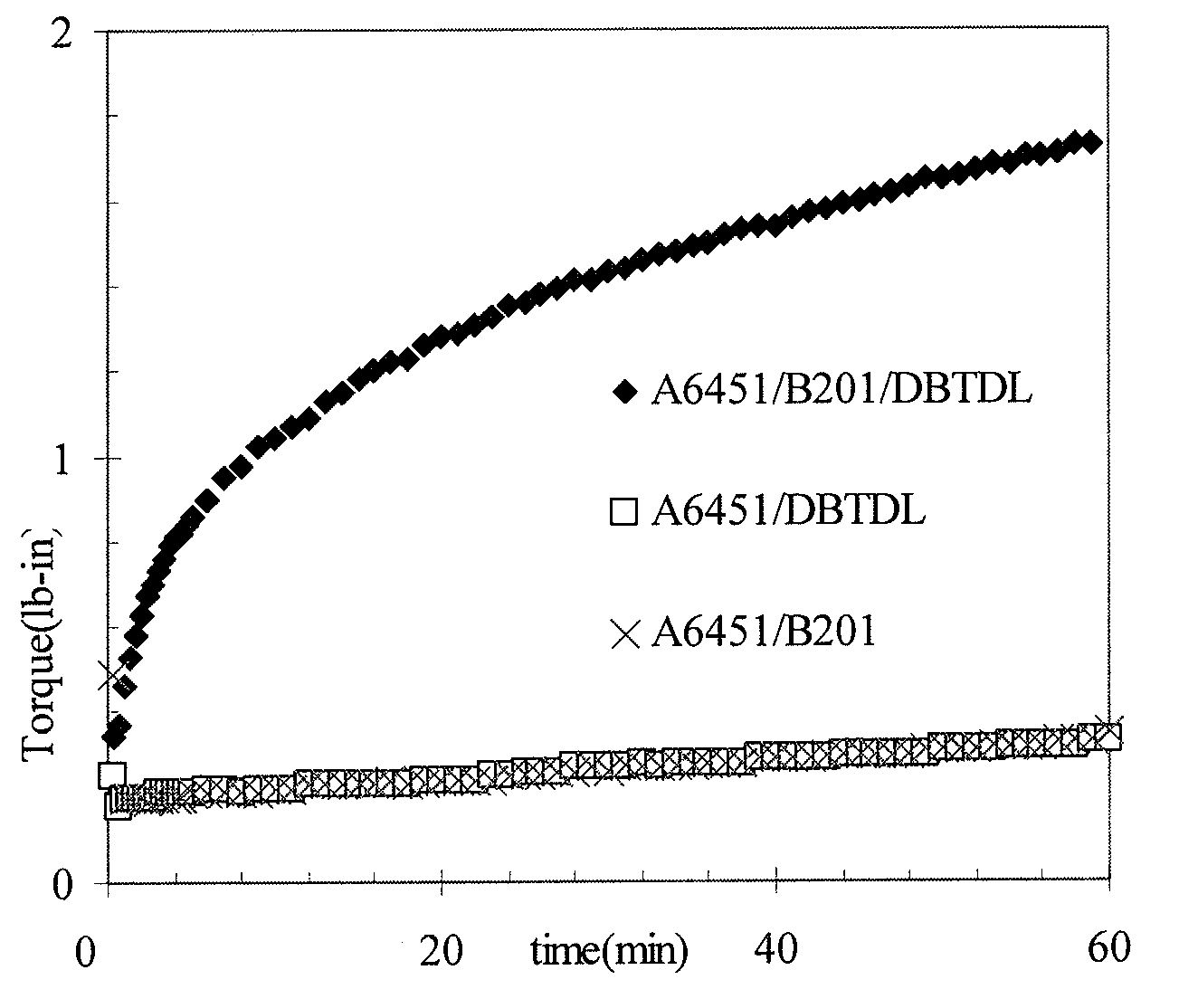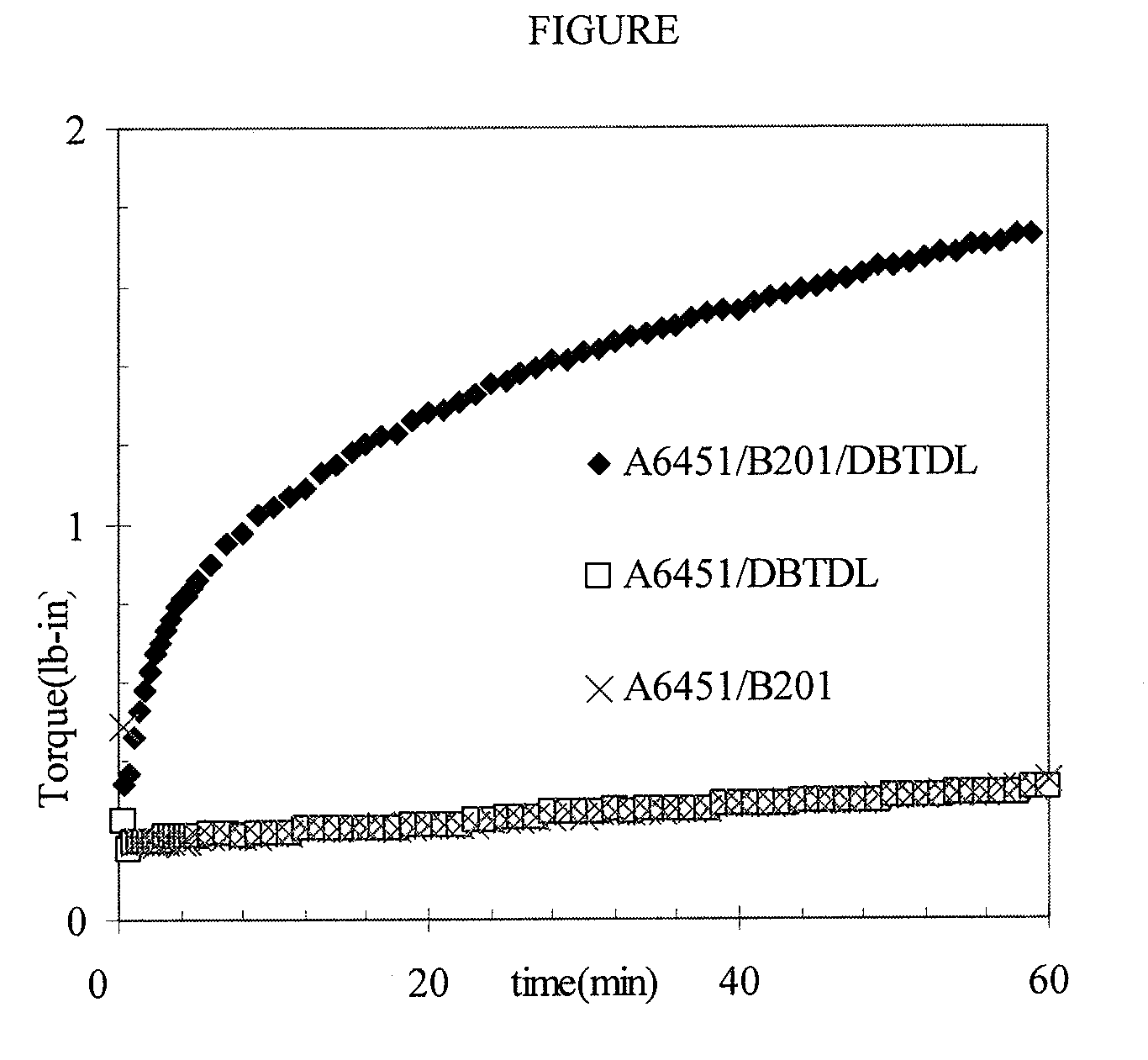Catalyst System for Moisture Cure of Ethylene-Vinylsilane Copolymers
a technology of ethylene-vinylsilane and copolymer, which is applied in the field of moisture cure of ethylene-vinylsilane copolymer, can solve the problems of requiring the use of relatively expensive acids, slow hydrophobic polymers, and high cost of acids, and achieve the effect of reducing the cure rate of ethylene-vinylsilane polymers
- Summary
- Abstract
- Description
- Claims
- Application Information
AI Technical Summary
Benefits of technology
Problems solved by technology
Method used
Image
Examples
specific embodiments
Comparative Example 1A
[0052]A catalyst masterbatch is made by mixing 97.2 grams (g) of a low density polyethylene (2 g / 10 min MI) with 2.6 g of dibutyltin dilaurate (DBTDL) and 0.20 g of LOWINOX® 22IB46 antioxidant (isobutylidene(4,6-dimethylphenol) available from Great Lakes Chemical) in a Brabender mixer at 30 revolutions per minute (rpm) for 5 minutes (min) at 125° C. The masterbatch is taken out and allowed to cool to room temperature after which it is pelletized.
[0053]Pelletized masterbatch (5 g) is mixed with 95 g of ethylene-vinyltrimethoxysilane copolymer in a Brabender at 30 rpm for 6 minutes at 125° C. Sample is taken out and allowed to cool to room temperature. Plaques (30 mil thickness) are made from this material in a hot press at 160° C. The plaques are cured at different conditions from which dog-bones are cut and hot-creep tests (ICEA Publication T-28-562-1995) are performed. The crosslinking dynamics are investigated using moving die rheometer (MDR) and the results ...
example 1
[0055]A catalyst masterbatch is made by mixing 97.2 g of the low density polyethylene used in the Comparative Examples with 1.3 g DBTDL, 1.3 g sulfonic acid (B201) and 0.20 g LOWINOX® 22IB46 in a Brabender at 30 rpm for 5 min at 125° C. The masterbatch is taken out and allowed to cool to room temperature after which it is pelletized. Plaques are prepared and tested using the same materials and techniques as those in Comparative Example 1A, and the results are reported in both the FIGURE and the Table.
TABLEPercent Elongation of 30 mil Plaques Cured at 23° C.and 70% Relative Humidityand Tested at 150° C. at 0.2 MPa for 15 MinutesSulfonic23° C.Acid g / DBTDL90° C. water bath70% RHExample100 gg / 100 g0 hr1 hr3 hr16 hr24 hrComp. Ex. 1A—0.13fail10454failfailComp. Ex. 1B0.13—fail453312583Ex. 10.060.06fail302514376*R.H. means relative humidity
Discussion
[0056]The rate of crosslinking in the MDR experiment, at a test temperature of 200° C., is very slow with either DBTDL alone or sulfonic acid a...
PUM
| Property | Measurement | Unit |
|---|---|---|
| Fraction | aaaaa | aaaaa |
| Percent by mass | aaaaa | aaaaa |
| Percent by mass | aaaaa | aaaaa |
Abstract
Description
Claims
Application Information
 Login to View More
Login to View More - R&D
- Intellectual Property
- Life Sciences
- Materials
- Tech Scout
- Unparalleled Data Quality
- Higher Quality Content
- 60% Fewer Hallucinations
Browse by: Latest US Patents, China's latest patents, Technical Efficacy Thesaurus, Application Domain, Technology Topic, Popular Technical Reports.
© 2025 PatSnap. All rights reserved.Legal|Privacy policy|Modern Slavery Act Transparency Statement|Sitemap|About US| Contact US: help@patsnap.com



